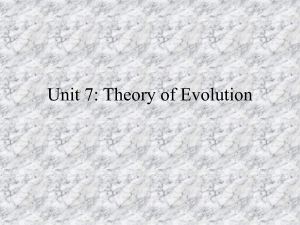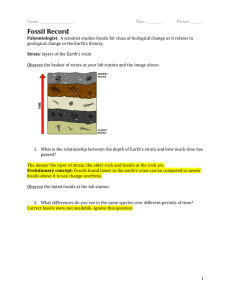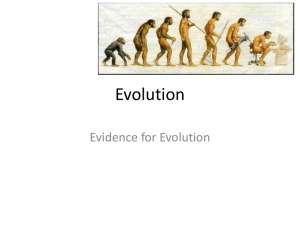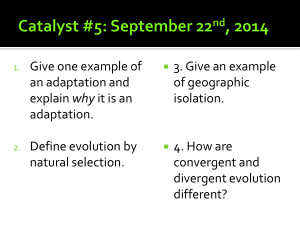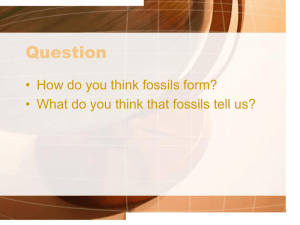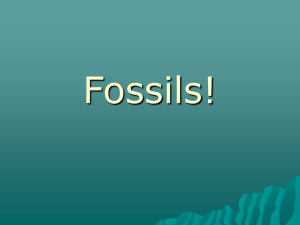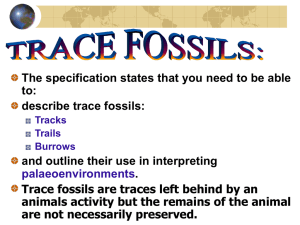Scientific Evidence for Evolution
advertisement
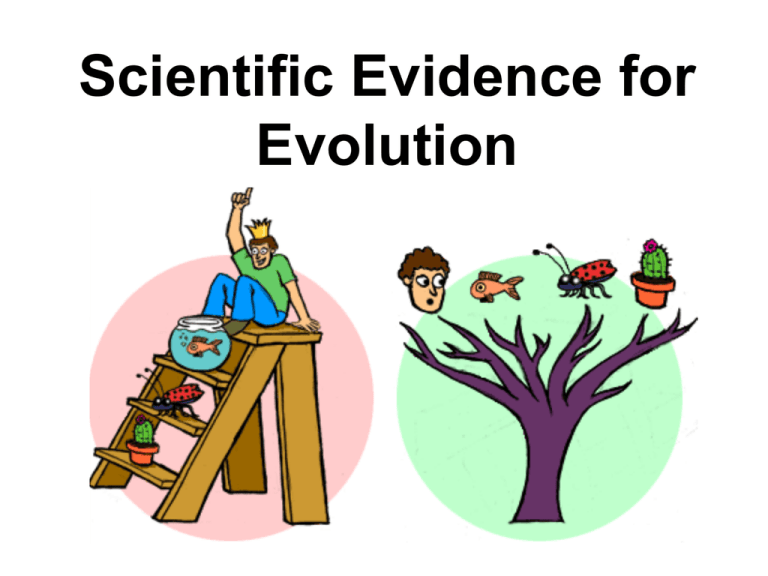
Scientific Evidence for Evolution Fossils Fossils are a strong piece of evidence to support the theory of evolution. Fossil = preserved remains or marking left by organisms that lived in the past. (Latin fossilis means “dug up”) Types of Fossils Sometimes full organisms can be preserved in sticky amber that hardens. Amber is a resin that is produced by trees – you should be familiar with this from Jurassic Park! Types of Fossils Organisms can be preserved for millions of years in very cold environments. An example of this is the woolly mammoth found recently in Russia. Types of Fossils In addition, animals can be trapped in tar and preserved like in the La Brea tar pits in LA. Types of Fossils By far the greatest numbers of fossils form on the bottoms of lakes and seas. Sometimes the shape of an organism is preserved in rock as a mold. Sometimes a mold fills with minerals and forms a cast which is a copy of the original organism. When impressions are made in mud, such as animal footprints, they are called imprints. Age of Fossils Most fossils are found in sedimentary rock… so called because sediments from eroded rock on land collect in rivers, seas and oceans and harden. Age of Fossils Over millions of years, the shifting of the earth’s crust has raised some regions that one were under the seas and the layers are visible. The Grand Canyon is an example. Age of Fossils What can you conclude about the age of these organisms in the layers of sedimentary rock? Why Fossils are Strong Evidence • The sequence of fossils is consistent all over the Earth = consistent evidence of change through time • Many transitional forms of fossils have been found (fish to amphibian, amphibian to reptile) Transitional forms in whale evolution Did you ever wonder why we have wisdom teeth? Vestigial Structures Scientists hypothesize that at one point, our ancestors needed these extra teeth! They are an example of a vestigial structure. Vestigial is a scientific word for “left-over.” These structures are usually reduced in size and serve little or no function. Scientists use the presence of vestigial structures as evidence that evolution has occurred. Other examples… Vestigial Structures In the human body there are more than 100 vestigial structures! Take the tailbone, for instance. It is the evolutionary remnant of a ancestral, reptilian tail! No muscles attach to it, it has nothing to do with balance or anything else. So then why do we have it? Vestigial Structures This is a picture of an appendix that is being removed because it is infected. Vestigial Structures Horses use their appendix to break down cellulose plant cell walls. Ours has no function! Does that mean ours lost its function as we evolved? Vestigial Structures And why do we have muscles to move our ears when they don’t work? (Except for that friend of yours that can wiggle their ears when they concentrate ) Vestigial Structures What do you notice about this whale skeleton? Vestigial Structures It has “left-over” hind leg bones!!! The tail side of the snake below also has remnants of a pelvis…. What could this mean?? Scientists conclude that both whales and snakes evolved from four-legged ancestors… Why else would they have these structures? Vestigial Structures 1.Fingernails on manatee fins which evolved from legs 2.Cave-dwelling organisms such as crayfish that have eyestalks but no eyes 3.Species of flightless beetles and birds that have wings. Okay, now that I have your attention… Do you remember what the study of structure is called? Anatomical Similarities If you said ANATOMY, you are right! There are certain structural similarities among living things that scientists point to as more evidence for evolution. Let’s take a look… Anatomical Similarities The structure of the arm and hand of a human, the flipper of a whale, the limb of a cat, the wing of a bat and the wing of a bird are quite different in appearance because they are adapted to perform different functions. Even with these different functions though, inside the structures are surprisingly similar… Anatomical Similarities Parts of different organisms that have similar internal structures, but different forms and functions are called HOMOLOGOUS STRUCTURES. Homologous structures are regarded as evidence that some species evolved from a common ancestor. Anatomical Similarities Be careful though! Sometimes animals have similar parts that are different in structure and development. Look below… Anatomical Similarities Although insects and birds both have wings, they are different in structure. An insect wing does not have bones at all – it is made of a tough substance called chitin. Structures that have similar external forms and functions but different internal structures are called ANALOGOUS STRUCTURES. These structures are NOT used as evidence for evolution. Two of these embryos are human, one is the embryo of a pig. Can you pick out the pig embryo? Comparing Embryos • It’s weird that you can’t really tell! But the one on the right is the pig embryo • Comparing the embryo development of different species can provide additional evidence of evolutionary relationships because embryos of closely related species show similar patterns of development. For example… Comparing Embryos • All vertebrate embryos have gill slits, two-chambered hearts and tails at some point in their development. • These similarities support the idea that they have a common origin. And now on to the last piece of major evidence for evolution…. Biochemical Comparisons All forms of life have DNA. There are leftover sections of DNA that are called junk DNA because they don’t have a purpose. Maybe they did at one time? Biochemical Comparisons A wide range of organisms from fruit flies to worms to mice to humans have very similar sequences of genes that are active early in development. Remember from the movie scientists put mouse eye genes in an eyeless fruit fly & eyes developed! What can this mean? These genes were present in a very early common ancestor of all these groups. Biochemical Comparisons On top of that… Proteins in all organisms are composed of the same set of 20 amino acids. And hemoglobin is found in almost every multicellular animal. The more closely related two organisms are, the more similar their DNA code is. Biochemical Comparisons For example, chimp DNA and human DNA are 98.2% similar! Well, what do you think? You must agree that the observations themselves cannot be refuted. However, do you agree with the interpretation of these observations and their use to support evolution? The particulars of the jump from nonliving to living that occurred sometime in our planet's early history is a profound enigma and will likely remain that way for some time to come, says Harvard's Andy Knoll. The hard part, and the part that I think nobody has quite figured out yet, is how you get them working together. How do you go from some warm, little pond on a primordial Earth that has amino acids, sugars, fatty acids just sort of floating around in the environment to something in which nucleic acids are actually directing proteins to make the membranes of the cell? In the early 1950s, Stanley Miller essentially put methane (natural gas), ammonia, hydrogen gas, and water vapor into a beaker. This was a view of what the primordial atmosphere would have looked like. He put an electric charge through that mixture to simulate lightning going through an early atmosphere. After sitting around for a couple of days, all of a sudden there was this brown goo all over the reaction vessel. When he analyzed what was in the vessel, rather than only having methane and ammonia, he actually had amino acids, which are the building blocks of proteins. In fact, he had them in just about the same proportions you would find if you looked at organic matter in a meteorite. So the chemistry that Miller was discovering in this wonderful experiment was not some improbable chemistry, but a chemistry that is widely distributed throughout our solar system.

